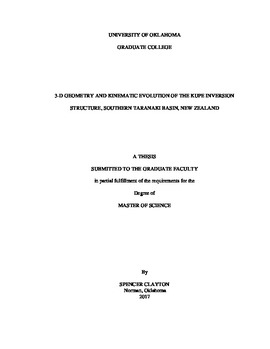| dc.description.abstract | The Southern Taranaki Basin underwent extension during the Late Cretaceous to Eocene, followed by a compression during the Oligocene to the Late Miocene, resulting in inversion of some of the pre-existing normal faults. The style of the structures and related faults varies depending on the relative magnitudes of extension and compression, and the orientation of the faults. The Kupe structure is related to two overlapping faults, the Manaia and Rua faults, with different magnitudes of slip along structural trend. A series of structural cross sections using the Kerry 3D seismic dataset and existing regional maps was made to develop a 3-D structural model of the Kupe structure. Kinematic reconstructions of the cross sections were used to validate the interpretations and understand the structural evolution. The magnitude of extension on the Manaia fault unit is greatest to the north, and decreases significantly to the south where it overlaps with the Rua fault. Inversion occurred during the Oligocene to Miocene, with the greatest magnitude of compression in the central part of the area. The inversion occurred primarily on the Manaia fault in this area, but fault slip was progressively transferred to the Rua fault in the south. Fault-bend folding along a listric fault with a deep decollement level within the basement was primarily responsible for the formation of the structure, but some fault-propagation folding and/or fault-independent folding was also important.
There is considerable variation in the structural styles along the trend of the structure. The northern part is dominated by a broad structure formed by fault-bend folding with a broad zone of fault propagation folding. The central transfer between the two faults is marked by a steep front limb and a tight zone of fault propagation folding is needed to explain this geometry. This area includes the structural closure drilled by the producing Kupe South well. The southern area is marked by a broad structure with a gently dipping front limb, and the progressive transfer of inversion from the Manaia to the Rua fault. | en_US |
